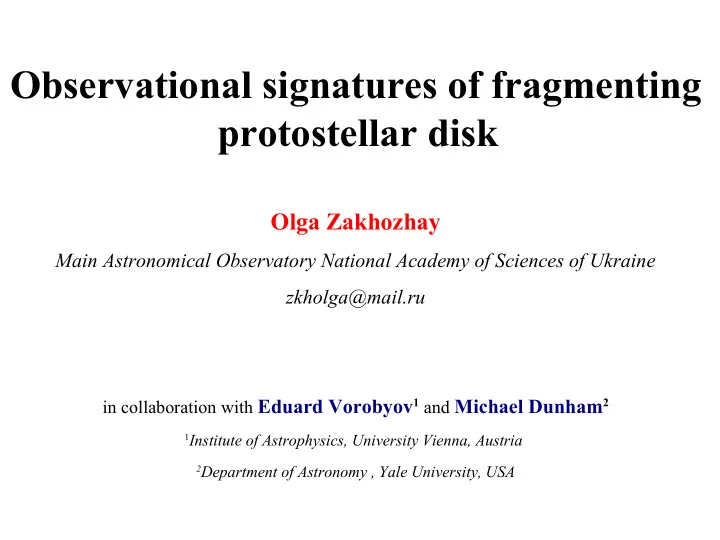

Observational signatures of fragmenting protostellar disk Olga Zakhozhay Main Astronomical Observatory National Academy of Sciences of Ukraine zkholga@mail.ru in collaboration with Eduard Vorobyov 1 and Michael Dunham 2 1 Institute of Astrophysics, University Vienna, Austria 2 Department of Astronomy , Yale University, USA
Global models that self-consistently follow Cloud => Disk transition Pre-stellar phase Class 0 and I phases T Tauri phase Disk formation and evolution, and planet formation, are integral parts of the star formation process 1+1D models (Hueso & Guillot 2005; Visser et al. 2009; Rice at al. 2010), 2D models (Yorke & Bodenheimer 1999; Boss & Hartmann 2001; Vorobyov & Basu 2006, 2010, Zhu et al. 2009), 3D models (Krumholz et al. 2007; Kratter et al. 2010; Machida et al. 2009, 2010).
Gas surface density and temperature maps for the model with initial core mass M = 1.23 M sun Gas surface density (g cm -2 ) Temperature (K)
Number of fragments vs. time Characteristic time of mass infall onto the disc M d – disk mass – mass infall rate onto the disk M d = 0.2 – 0.25 M sun = (2 – 3) 10 -6 M sun yr -1 t infall = 0.07 – 0.12 Myr
Properties of fragments
Zoomed-in surface density images for four proto-BDs (characterized by midplane temperature >10 3 K) Hill radius M f – mass of the fragment (proto-BD) r f – radial distance from the protostar to the fragment
Calculation algorithm for the SEDs = + F F F disk * Protostar Disk = + F F F disk d sc Disk Sink cell d – distance to YSO, 250 pc κ ν – opacity ( Ossenkopf & Henning 1994 , thin ice mantles (OH5 dust))
Test of the code where, T * = 4000 K R * = 2.5 R sun r out = 200 AU (270 AU) Chiang & Goldreich 1997
Surface density maps and SEDs for the fragmenting disk proto-BD proto-BD M = 55 M Jup M = 32 M Jup T mp = 1660 K T mp = 1180 K proto-BD proto-BD M = 52 M Jup M = 64 M Jup T mp = 1190 K T mp = 1375 K
Surface density maps and SEDs for the fragmenting disk Star+disk are embedded within a core proto-BD proto-BD M = 55 M Jup M = 32 M Jup T mp = 1660 K T mp = 1180 K proto-BD proto-BD M = 52 M Jup M = 64 M Jup T mp = 1190 K T mp = 1375 K
Surface density maps and SEDs for the non-fragmenting disk
Simulated ALMA images (log (mJy beam -1 ), 1 hour, 0.1″)
Simulated ALMA images, (mJy beam -1 , 1 hour, 0.1″)
Simulated ALMA images, (log (mJy beam -1 ), 1 hour, 0.5″)
Conclusions Disk experiences multiple episodes of fragmentation in the embedded phase : ● mass distribution function: maxima around 5 M J and 60-70 M J , ● mass spectrum: from about Jupiter mass to very-low-mass stars. ● Majority of fragments surface temperatures T surf <100K due to high optical ● depths. Some fragments: interior temperatures sufficient to evaporate dust grains. ● These fragments have much higher surface densities and create a peak at ≈ 5μm in t he SEDs. Fragments can be detected with ALMA (1 hour, 0.1"). ● detection limit: 1.5 M J (at 250 pc). ● use a log scaling to resolve the spiral structure and fragments at ≤ 100 AU. ● use oversaturated linear scaling to detect distant and low-mass fragments. ● with resolution of 0.5" fragments may be detected at distances ≤ 150 pc. ●
Model caveats Uncertainties in dust opacity • Non-zero inclination Dust sublimation temperature (1500K) T d.s. = 1000K, F max 18%, at λ = 1.2 μ m T d.s. = 2000K, F max 46%, at λ = 1.75 μ m
Recommend
More recommend